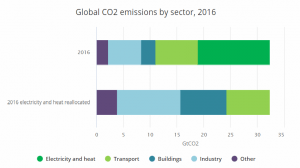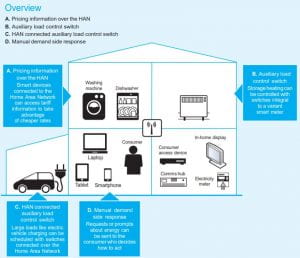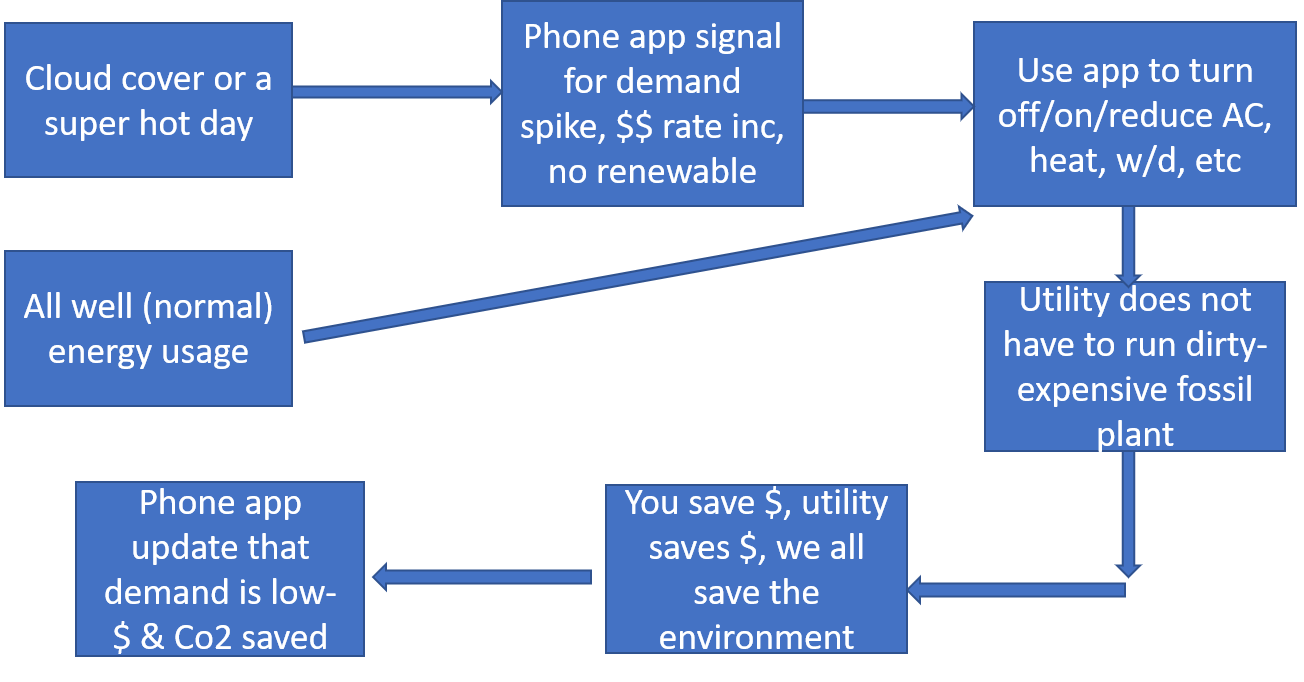SDG 7 – Ensure access to affordable, reliable, sustainable and modern energy for all.
SDG 12- Responsible Consumption and Production
SDG 13- Climate Action
Its 2019 and we finally have a lot of global momentum and conversation around climate change, the role of energy sector in sustainability efforts, and bringing along the bottom of the pyramid that is still struggling with inadequate, or no, energy access, clean or otherwise. While a lot of positive work is happening around greater renewable integration in our power supply, cleaner fossil fuel technologies, energy access, and energy efficient buildings, a lot can also be achieved by using the existing energy infrastructure and power sources more wisely. Electricity and heating sector contributes to roughly 30-35% of all CO2 emissions, and hence we would like to explore electric utilities, their current business model, and how increased involvement of customers as a business model innovation can lead to responsible use of energy and greater efficiency in the use of current energy infrastructure as a tool to address sustainability and SDG 7 targets. Through this post, we look to explore current efforts in consumer engagement through smart meters and demand response programs, and how, if at all, this can be implemented in the developing world.


Electrical Utility and distribution company
Industry Description
An electrical utility company is a company that produces, transmit and/or distributes electricity through its network. More specifically, the distribution electricity company is the last electrical utility company involved in the delivery of electric power. It makes the link between suppliers and end consumers. It also receives electricity from renewable sources produced locally.
Electricity consumed by customers is measured thanks to electricity meters which allow the distribution company to bill the client. The network is monitored by remote operations centers, deciding in real time about the quantity of electricity to inject. The current trend is to install more and more smart devices on the network (communicative meters, automatic regulators…) to get more accurate information in real time and automate its operations as much as possible. The grid becomes smarter and smarter.

Current Business Model
Electricity is distributed through aerial or buried networks.
One network conveys electricity from the different electricity providers to the final consumer. Energy providers buy a right to use a capacity on the network at a certain time in an auction system. The company in charge of the network operation deals with the distribution of volumes between the different Electricity providers and makes the customer billing. For renewable energy, the electricity produced is bought by an electricity provider company and distributed through the same network.
Part of each electricity bill contains the electricity distribution costs. Depending on the country, it represents 10 to 30% of the bill.
Energy utility assets and business model have been very safe in the past but with the emergence of disintermediation technologies and a falling customer willingness to pay, the future of this business model is uncertain.
Major disruption are expected in the industry :
- grid parity of renewable energy distributed generation,
- lower cost and mass-scale storage solutions,
- secure and efficient micro-grids,
- attractive electric vehicle options and
- smart meter devices and applications.
Two key challenges will be : first, to facilitate grid interconnection between transmission operators in order to get more flexibility in the discontinuous renewable energy integration, second to extend the deployment of new technologies and equipment on the distribution network without compromising its operation.
Entering the market will be more and more difficult for new comers since a precise knowledge of where and how to play is required as well as an accurate customer understanding.
In the traditional business model, making money mainly consisted in investing in the asset and earning a return on the capital invested. Technologies are now cost efficient, in the new emerging business models, money is expected to be made by obtaining higher margin rather than by reducing costs
Current sustainability Goals
According to the united nation development program, Goal n°7 aims at providing affordable and clean energy. The objective are by 2030 to :
- ensure universal access to affordable, reliable and modern energy services
- increase substantially the share of renewable energy in the global energy mix
- double the global rate of improvement in energy efficiency
- enhance international cooperation to facilitate access to clean energy research and technology, including renewable energy, energy efficiency and advanced and cleaner fossil-fuel technology, and promote investment in energy infrastructure and clean energy technology
- expand infrastructure and upgrade technology for supplying modern and sustainable energy services for all in developing countries, in particular least developed countries, small island developing States, and land-locked developing countries, in accordance with their respective programmes of support
Therefore, an electric utility company has a real card to play to help reaching those objectives.
The current business model already enables many customers to access the electricity resource at a moderate price and manages to integrate renewable energies.
Governments are now enforcing laws challenging existing electric utilities in their performance. This is of importance because the electric utility significantly weights in the financing model of new solutions implemented for the energy transition toward more sustainable energies. In Europe for example, regulation requires vertically integrated companies like EDF or GDF to unbundle so that each part of the company (distribution, transportation, storage…) can be challenged on a wholesale market by external companies and new entrants. This measure is supposed to drive costs down.
In parallel, digital technologies are encouraged to create new business models such as virtual power plants. This model facilitates energy exchanges on small scale and enables third parties to pool their production, capacity, flexibility. The intermittent renewable energy production is then compensated by different sources of renewable energies virtually associated.
This evolution of the regulatory environment for energy utility facilitates the introduction of new business models and shifts the incentives from capital spending to cost efficiency, reliability, performance and added value.
Eventually, fast-growing new technologies like electric vehicles, battery storage… will also modify the way electricity is distributed and stored. This will influence the energy utility sector as a whole.
Where it falls short
While considering all those kinds of new business models, one can be surprised that consumers are not involved in the process. The consumer doesn’t know its impact on the energy production and consumption, most of the solutions focus on the technical aspect of the energy supply. The behavioral aspect is not really addressed yet.
Consequently, the consumer can not adjust its consumption and act as an actor of the electricity supply chain. The underlying idea is to make the customer interfere with the system by giving him a set of incentives that will help the electric utility company to distribute the power in the most efficient way. To provide the customer with this information, the distribution company will need to precisely track in real time the quantity of electricity delivered. This is done thanks to a smart meter.
New business model innovation- Smart Meter & Changing Consumer Behavior
Context
Building on the discussion above, the two biggest changes in the energy and transport sector to support SDG goals in recent times are-
- Renewable power- Economic viability plus regulatory policy push is gradually increasing the world’s use of renewable energy for energy. As of 2016, on an average, 30% of energy capacity of the world came from clean and renewable sources like hydro, wind, solar, etc.
- Electric Vehicle- In 2017, 3million cars in circulation were electric vehicles; this was 50% more than 2016, and this number continues to rise.
Even with the great efforts in the two areas mentioned above, we are left with some important questions-
- When will people charge their Electric Vehicles and what fuel source would be used for the electricity that is charging the vehicle? If I use coal generated power to charge my electric vehicle, is that negatiting the positive impact of driving an electric vehicle? Is there some way to encourage people to charge during the day or evening when solar and wind power are abundant?
- People consume more electricity year after year; global electricity demand rose by 4% in 2018. So we produce more, and then people consume more, and the cycle goes on. Even though we are increasing our use of renewable power to meet this increasing consumption, what happens on a rainy/cloudy day? We need to plan for backup fossil generation as contingency. Is there a way we can make people consume when we can generate more renewable power and less when we have to use dirtier fossil power?
The answer to both those questions is YES, and this is where Smart Grid comes in. Smart Grid is the business model innovation that will put consumers at the heart of utility business. The term “smart grid” represents a set of technologies, including advanced meters, sensors and energy storage that are crucial for the integration of more electric vehicles, renewable, and low carbon electricity into the electric power grid.

How does it work?



Imagine you live in sunny California. Let’s say you live in Los Angeles. You have roof top solar panels in your home. California has a lot of solar generated power (large scale and roof top) from 9am to 6pm. Starting 6pm, as sun goes down, California must use fossil power generation (with some wind power generation) to meet all your electricity demands. Unfortunately, battery technology is still not economical enough for us to store all our excess solar during the day and use it at night. Its 2pm and you are at work. Your roof top solar is generating more than the power your home needs, which at 2pm is low air conditioning and the lights you mistakenly left on this morning. Your Tesla Electric Vehicle is happily parked outside your office, and life is good. You get home at 7pm and you turn up the air conditioning, switch on your TV, plug in your Tesla to charge, and start running your laundry and dishwasher. The ‘Smart Energy’ app on your phone starts beeping and giving you alerts for how much fossil energy you are consuming and much emission you could have saved had you done some of these tasks during the day when California had all that excess solar. The same could happen on a hot summer Sunday 3pm, when you and your family are home, and total California electricity demand is way more than what renewables can handle. Your ‘Smart Energy’ app gives you a price alert and an emission alert and you decide to switch off your washer, dryer, and dishwasher, and run it later in the evening when fossil fuel Peaker power plants aren’t being used. You save yourself money, you save tons of emissions, and you make a conscious change in your consumption habit for what is good for the environment
Financial model & Social/Environmental challenges addressed
Smart grid has the potential to deliver multiple societal benefits including a more reliable and secure energy sector, a more powerful economy, a cleaner environment, and an empowered citizenry engaged in energy system management.
- Economic: Reduce the cost of new transmission, save consumers money on electricity costs, consumers save money by reducing or shifting electricity use, utility saves money as they don’t have to run that expensive generator, and utility makes money on the sale of the meters
- Political: Meet political goals associated with energy efficiency, meet state or corporate demand response policies
- Environmental: Reduce electrical use, reduces associated emissions and environmental harm, lower emissions through conservation, reduced use of dirty peaking plants
- Cultural: Culture of traditional utility industry towards risk stifling innovation, increase customer awareness of energy consumption and engage customers
- Health and Safety: Reduced electricity use could help to improve air quality, affect exposure to air pollution
While emission reduction and cost savings is extremely advantageous, in the long run, changing consumer behavior and reprogramming human electricity consumption would have HUGE widespread benefits. We could train ourselves to become more sensitive to environmental and economic signals to decide when to charge our electric vehicle and when to wash our clothes. This habit, when shared with our family and kids will create a new generation of wise, informed, and energy conscious consumers. All of the utility and energy policy programs, clubbed with a wiser consumer, would finally deliver the much needed sustainable impacts of climate-change mitigation action plans.
Is anyone doing this? Of course, California is 🙂
In early 2010s pilot programs in California using smart meters, time-of-use pricing, and smart apps has shown as much as 15-20% reduction in peak day energy usage in residential areas.
This lead to massive rollout of smart meter and smart home apps. As of 2017, 47% of all meters in the US were smart meters. This was followed by time-of-use pricing alerts on these smart aps to enough users when demand is too high to be met by cheap-clean sources of power. “Accenture’s New Energy Consumer 2016 research found customers are ready for automated home energy management; 75% of consumers are interested in home energy management systems (HEMS) and 25% of respondents are willing to pay for it”
Is anyone else doing this and encountering difficulties ? Yes ! France !!
Let us tell you the story. From 2015, the French electrical utility company Enedis is installing its smart electricity meters.
Consumers theoretically have no choice since meters don’t belong to them. However, in many cases, this meter is inside people’s home and the installer needs an access.
Rumors began to spread that gas meters would contain a mini computer able to track and record people’s consumption very accurately, enabling the Energy Utility company to collect data and detect which electrical device is currently working and/or if someone is at home or not. People became suspicious, the Electrical Utility did not address those concerns. “stop Linky non merci” campaigns (meaning “stop to the electricity meter, no thank you !” ) started to spread. The population began to organize.


In addition, independent studies were led, showing that new smart meters emit more electromagnetic waves particularly harmful for electro-sensible people while others indicate that the waves are not more dangerous than the TV remote control waves.
In some cities (Bovel, Sommières…), mayors simply refused Enedis to install its smart meters, provoking delays in the installation program. More than 5000 people are now part of the anti-smart meter movement, highlighting the fact that in the end, the end consumer will pay for the new smart meter through an electricity bill increase while meter readers jobs will be suppressed.
In this uncertainty and without appropriate communication from the electric distribution company, public opinion is shifting. Benefits expected in California are less likely to occur.
This case emphasizes how important it is to prepare change and communicate thoroughly while installing smart technologies.
Could we use this in the developing world?

While this sounds like a great idea for the developed world with full technology and energy access, would this work in Africa or India where not only >30% population has no energy access, but also the smartphones and apps have not made their way into all the households with electricity. This probably won’t resolve energy access issues for areas that have no infrastructure to support electricity flow.
Let’s look at India, since that’s where one of our group members is from 🙂
Growing up in India, hours of power cut was a part and parcel of life, and that story sadly hasn’t changed.
Lack of enough cheap generation and transmission-distribution losses are the biggest causes of power outages in India.
Integrating smart meter into utility business model can help reduce both these issues. Even if we just aim at the top 20% of India- urban-rich population that uses much more electricity than rural and poor households, we can reduce enough peak load to reduce power cuts, and hence improve energy availability. The big challenge will be cost of implementation and willingness of the rich to change behaviour for the benefit of the power.
https://www.youtube.com/watch?v=3ZLqlPxvWGo
Authors
Clemence Malinge
Lucas Murata
Mudita Suri
Sources
- https://www.iea.org/statistics/co2emissions/
- https://www.iea.org/newsroom/news/2017/december/commentary-changing-utility-business-models-and-electricity-investment.html
- https://ourworldindata.org/renewable-energy
- https://www.iea.org/gevo2018/
- https://www.iea.org/geco/electricity/
- https://assets.publishing.service.gov.uk/government/uploads/system/uploads/attachment_data/file/579774/291116_-_Smart_meters__Demand_Side_Response_leaflet_-_DR_-_FINAL.PDF
- https://www.elp.com/articles/print/volume-83/issue-3/departments/news/california-pricing-experiment-yields-new-insights-on-customer-behavior.html
- https://www.energycentral.com/c/ec/pay-attention-utilities-your-customers-relationship-electricity-changing) “Accenture’s New Energy Consumer
- http://www.ijoart.org/docs/Power-cut-off-and-Power-Blackout-in-India-a-Major-threat–An-Overview.pdf
- https://www.westernpower.co.uk/electrical-losses
- https://www.mdpi.com/2078-1547/4/2/217
- https://smallbiztrends.com/2017/08/mobile-apps-to-help-you-reduce-energy-costs.html
- https://www.latimes.com/business/la-fi-solar-batteries-renewable-energy-california-20190605-story.html
- https://www.theguardian.com/money/2017/jun/24/smart-meters-spying-collecting-private-data-french-british
- https://selectra.info/energie/actualites/acteurs/opposants-compteur-linky-enedis
- https://www.60millions-mag.com/2016/06/15/faut-il-avoir-peur-de-linky-10483
- https://www.pwc.com/gx/en/utilities/publications/assets/pwc-future-utility-business-models.pdf

Thank you all for the great post and the nice presentation. Very intriguing topic. While technically probably not as easy as it sounds, it seems relatively “low-hanging fruit” to implement these solutions at scale as they combine an economic incentive with doing good. Interesting to see how the shift towards 5G devices and more connected homes will prove a catalyst for these initiatives.